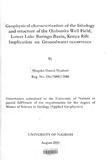| dc.description.abstract | The task of the research project is the use of geophysical technologies for the characterization of
the lithology and structure beneath the Olobanita well field, and determine their implications on
the groundwater drilling operations in the basin. Development of the aquifer since the 2000’s to
date by the government agencies and its development partners through drilling, has resulted in
generation over time of data and information on its water resources. Consequently, borehole
collapse problems have been reported that have resulted from the drilling activities. This has
been used by my research as a guide to the study of the subsurface of the well field. Geophysical
techniques employed includes electrical resistivity (vertical electrical sounding (VES) and
electrical resistivity tomography (ERT)), magnetics and geospatial techniques like geographical
information systems (GIS) and global positioning system (GPS) for development of maps.
The Olobanita Basin with an area of 625km2, a volcano-sedimentary basin is located in the
Central Kenya Rift, Nakuru district of Rift Valley Province. It is located between latitudes 0000’N
and 0015’ S and longitudes 36000’ and 36015’ E. For the study, establishments on the subsurface
geology of the wellfield were made from; borehole geologic logs, vertical electrical sounding
interpreted data, electrical resistivity tomographic interpreted data and magnetic data analysis
results and reports by other researchers.
The vertical electrical sounding and the 2-Dimension (2D) Resistivity imaging allowed a
distinction to be made between very high resistive volcanic sands, the moderately high resistivity
freshwater saturated zone and the very low resistive clays in localised areas. The geological
interpretation of the surveys correlated very well with the borehole data. Vertical faults have
resulted in minor down-throwing of blocks in areas close to the rift wall on the east and some
few metres to the west margins of the VES grid area. It is concluded that the well-field lies in a
volcano-sedimentary basin, where the results from the analysis shows that there exists volcanic
sand and silt formation to a depth of about 40 metres underlain by volcanic ashes and fragments
to a depth of about 80 metres with intercalations of hard rock formations mainly; welded tuffs
and trachyte. These loose unconsolidated geologic materials are vulnerable to collapsing by any
chance of disturbance. To the depth beyond 80 metres to about 300 metres exists loose
sediments with rounded fragments; thus, contributes to the borehole blockage and collapsing
challanges. | en |

